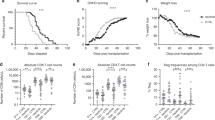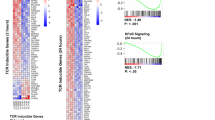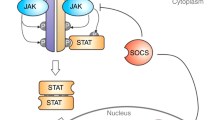Abstract
Graft-versus-host disease (GVHD) is the major factor limiting the widespread use of potentially curative allogeneic hematopoietic stem cell transplant (allo-HSCT). Chronic GVHD is characterized by the activation of alloreactive donor immune cells, especially B- and T-cells, leading to tissue damage and pathogenic fibrosis. In this study, we used highly specific next-generation inhibitors of ITK (PCYC-274), BTK (PCYC-804), and ibrutinib-like BTK/ITK inhibitors (PCYC-914 and PCYC-401) in the B10.D2 → BALB/C model of murine sclerodermatous cGVHD. From the third week onward, allogeneic recipients in each group of respective Tec kinase inhibitors were treated three times weekly with inhibitors at doses of 10 and 30 mg/kg or with saline control via oral gavage. Overall, we found that selective BTK inhibition was less effective than combined ITK/BTK or ITK inhibition in lengthening survival and reducing symptoms of cGVHD. ITK inhibition was most efficacious, with PCYC-274 and PCYC-401 demonstrating a nearly 50 percent reduction in GVHD scoring even at the 10 mg/kg dose, while 30 mg/kg of these compounds almost completely ameliorated GVHD symptomology. BTK/ITK and ITK-treated mice showed significant reductions in overall pathology. Significant reductions in dermal thickness and fibrosis were shown for all treatment groups. There was evidence of mixed Th1 and Th2 cytokine profiles in the skin of mice with dermal cGVHD, as both IFN-gamma and IL-4 were upregulated in the allogeneic control group, while kinase inhibition significantly reduced levels of these cytokines. Using an in vitro model of T-cell polarization, Th1 cell production of TNF-alpha and IFN-gamma were partially blocked by ITK. Th2 cell production of IL-4 was almost completely blocked synergistically by ITK and BTK inhibition. BTK-specific inhibition was unable to block either Th1 or Th2 cytokine production. Taken together, these results confirm previous reports that ITK-focused inhibition inhibits Th1 and Th2 cells. Additionally, the compound’s effects on T-cell proliferation were tested by CFSE assay. Pure ITK inhibition was most effective at blocking T-cell proliferation, with no proliferation in PCYC-274-treated cells even at 0.1uM. PCYC-401 and PCYC-914 showed some inhibition at lower doses, with complete inhibition evident at 10uM. PCYC-804 was only partially able to block proliferation even at 10uM. In conclusion, we observed substantial benefit for differential inhibition of Tec kinases in GVHD, with ITK being most efficacious and Th1 cells being more resistant to inhibition, matching the previously reported findings of a Th2 to Th1 selective pressure in cells treated with ibrutinib. Our data warrants the further development of ITK and ITK/BTK inhibitors with specific inhibitory ratios to improve the treatment of GVHD and other T-cell mediated diseases.
This is a preview of subscription content, access via your institution
Access options
Subscribe to this journal
Receive 12 print issues and online access
$259.00 per year
only $21.58 per issue
Buy this article
- Purchase on Springer Link
- Instant access to full article PDF
Prices may be subject to local taxes which are calculated during checkout





Similar content being viewed by others
Data availability
All data generated or analyzed during this study are included in this published article, the datasets generated during and/or analyzed during the current study are available from the corresponding author on request.
References
Hamadani M, Craig M, Awan FT, Devine SM. How we approach patient evaluation for hematopoietic stem cell transplantation. Bone Marrow Transpl. 2010;45:1259–68.
Ali N, Adil SN, Shaikh MU, Masood N. Frequency and Outcome of Graft versus Host Disease after Stem Cell Transplantation: A Six-Year Experience from a Tertiary Care Center in Pakistan. ISRN Hematol. 2013;2013:232519.
Flynn R, Du J, Veenstra RG, Reichenbach DK, Panoskaltsis-Mortari A, Taylor PA, et al. Increased T follicular helper cells and germinal center B cells are required for cGVHD and bronchiolitis obliterans. Blood. 2014;123:3988–98.
Shimabukuro-Vornhagen A, Hallek MJ, Storb RF, von Bergwelt-Baildon MS. The role of B cells in the pathogenesis of graft-versus-host disease. Blood 2009;114:4919–27.
Reddy P, Ferrara JLM. Immunobiology of acute graft-versus-host disease. Blood Rev. 2003;17:187–94.
Harris AC, Young R, Devine S, Hogan WJ, Ayuk F, Bunworasate U, et al. International, Multicenter Standardization of Acute Graft-versus-Host Disease Clinical Data Collection: A Report from the Mount Sinai Acute GVHD International Consortium. Biol Blood Marrow Transpl. 2016;22:4–10.
Arai S, Jagasia M, Storer B, Chai X, Pidala J, Cutler C, et al. Global and organ-specific chronic graft-versus-host disease severity according to the 2005 NIH Consensus Criteria. Blood 2011;118:4242–9.
Zeiser R, Blazar BR. Pathophysiology of Chronic Graft-versus-Host Disease and Therapeutic Targets. Longo DL, editor. N. Engl J Med. 2017;377:2565–79.
Chien JW, Duncan S, Williams KM, Pavletic SZ. Bronchiolitis obliterans syndrome after allogeneic hematopoietic stem cell transplantation-an increasingly recognized manifestation of chronic graft-versus-host disease. Biol Blood Marrow Transpl. 2010;16:S106–114.
Dubovsky JA, Flynn R, Du J, Harrington BK, Zhong Y, Kaffenberger B, et al. Ibrutinib treatment ameliorates murine chronic graft-versus-host disease. J Clin Investig. 2014;124:4867–76.
Cooke KR, Kobzik L, Martin TR, Brewer J, Delmonte JJ, Crawford JM, et al. An experimental model of idiopathic pneumonia syndrome after bone marrow transplantation: I. The roles of minor H antigens and endotoxin. Blood 1996;88:3230–9.
Karaman MW, Herrgard S, Treiber DK, Gallant P, Atteridge CE, Campbell BT, et al. A quantitative analysis of kinase inhibitor selectivity. Nat Biotechnol. 2008;26:127–32.
Zhong Y, Dong S, Strattan E, Ren L, Butchar JP, Thornton K, et al. Targeting Interleukin-2-inducible T-cell Kinase (ITK) and Resting Lymphocyte Kinase (RLK) Using a Novel Covalent Inhibitor PRN694. J Biol Chem. 2015;290:5960–78.
Miklos D, Cutler CS, Arora M, Waller EK, Jagasia M, Pusic I, et al. Ibrutinib for chronic graft-versus-host disease after failure of prior therapy. Blood 2017;130:2243–50.
Dubovsky JA, Beckwith KA, Natarajan G, Woyach JA, Jaglowski S, Zhong Y, et al. Ibrutinib is an irreversible molecular inhibitor of ITK driving a Th1-selective pressure in T lymphocytes. Blood 2013;122:2539–49.
Cho HS, Shin HM, Haberstock-Debic H, Xing Y, Owens TD, Funk JO, et al. A Small Molecule Inhibitor of ITK and RLK Impairs Th1 Differentiation and Prevents Colitis Disease Progression. J Immunol. 2015;195:4822–31.
Miller AT, Wilcox HM, Lai Z, Berg LJ. Signaling through Itk promotes T helper 2 differentiation via negative regulation of T-bet. Immunity 2004;21:67–80.
Horwood NJ, Urbaniak AM, Danks L. Tec family kinases in inflammation and disease. Int Rev Immunol. 2012;31:87–103.
Calcaterra C, Sfondrini L, Rossini A, Sommariva M, Rumio C, Ménard S, et al. Critical Role of TLR9 in Acute Graft-versus-Host Disease. J Immunol. 2008;181:6132–9.
Berg LJ, Finkelstein LD, Lucas JA, Schwartzberg PL. Tec family kinases in T lymphocyte development and function. Annu Rev Immunol. 2005;23:549–600.
Atherly LO, Lucas JA, Felices M, Yin CC, Reiner SL, Berg LJ. The Tec family tyrosine kinases Itk and Rlk regulate the development of conventional CD8+ T cells. Immunity 2006;25:79–91.
Conley JM, Gallagher MP, Berg LJ. T Cells and Gene Regulation: The Switching On and Turning Up of Genes after T Cell Receptor Stimulation in CD8 T Cells. Front Immunol. 2016;7:76.
Greinix HT, Pohlreich D, Kouba M, Körmöczi U, Lohmann I, Feldmann K, et al. Elevated numbers of immature/transitional CD21- B lymphocytes and deficiency of memory CD27+ B cells identify patients with active chronic graft-versus-host disease. Biol Blood Marrow Transpl. 2008;14:208–19.
Kuzmina Z, Greinix HT, Weigl R, Körmöczi U, Rottal A, Frantal S, et al. Significant differences in B-cell subpopulations characterize patients with chronic graft-versus-host disease-associated dysgammaglobulinemia. Blood 2011;117:2265–74.
Allen JL, Fore MS, Wooten J, Roehrs PA, Bhuiya NS, Hoffert T, et al. B cells from patients with chronic GVHD are activated and primed for survival via BAFF-mediated pathways. Blood 2012;120:2529–36.
Waller EK, Miklos D, Cutler C, Arora M, Jagasia MH, Pusic I, et al. Ibrutinib for Chronic Graft-versus-Host Disease After Failure of Prior Therapy: 1-Year Update of a Phase 1b/2 Study. Biol Blood Marrow Transplant. 2019;25:2002–7.
Jaglowski SM, Blazar BR. How ibrutinib, a B-cell malignancy drug, became an FDA-approved second-line therapy for steroid-resistant chronic GVHD. Blood Adv. 2018;2:2012–9.
Pharmacyclics LLC. A Randomized, Double-Blind Phase 3 Study of Ibrutinib in Combination With Corticosteroids Versus Placebo in Combination With Corticosteroids in Subjects With New Onset Chronic Graft Versus Host Disease (cGVHD) [Internet]. clinicaltrials.gov; 2021 Jun [cited 2021 Sep 8]. Report No.: NCT02959944. https://clinicaltrials.gov/ct2/show/NCT02959944
Rezvani A. A Phase 2 Study of Ibrutinib Maintenance After Reduced-Intensity Conditioning and Allogeneic Hematopoietic Cell Transplantation for Acute Leukemia [Internet]. clinicaltrials.gov; 2021 Jan [cited 2021 Sep 8]. Report No.: NCT03267186. https://clinicaltrials.gov/ct2/show/NCT03267186
Zeiser R, von Bubnoff N, Butler J, Mohty M, Niederwieser D, Or R, et al. Ruxolitinib for Glucocorticoid-Refractory Acute Graft-versus-Host Disease. N. Engl J Med. 2020;382:1800–10.
Zeiser R, Socié G, Schroeder MA, Abhyankar S, Vaz CP, Kwon M, et al. Efficacy and safety of itacitinib versus placebo in combination with corticosteroids for initial treatment of acute graft-versus-host disease (GRAVITAS-301): a randomised, multicentre, double-blind, phase 3 trial. Lancet Haematol. 2022;9:e14–25.
McLeod JJA, Baker B, Ryan JJ. Mast cell production and response to IL-4 and IL-13. Cytokine 2015;75:57–61.
Dispenza MC, Krier-Burris RA, Chhiba KD, Undem BJ, Robida PA, Bochner BS. Bruton’s tyrosine kinase inhibition effectively protects against human IgE-mediated anaphylaxis. J Clin Investig. 2020;130:4759–70.
Acknowledgements
This research was supported by the Biospecimen Procurement & Translational Pathology Shared Resource Facility of the University of Kentucky Markey Cancer Center (P30CA177558). UK Flow Cytometry and Cell Sorting Core Facility: Supported by the Office of the Vice President for Research, the Markey Cancer Center, and an NCI Center Core Support Grant (P30CA177558). UK COBRE pathologic Core, University of Kentucky, National Institutes of General Medical Sciences, NIH grant 8 P20 GM103527. The work was supported by a preclinical investigational grant from Pharmacyclics.
Author information
Authors and Affiliations
Contributions
SP and ES designed and performed experiments, analyzed results, and co-wrote the article. RK, MM, MA, FB, LW, ZJ, TG and RH assisted in conducting the experiments. NH and MK analyzed histology scoring. SP and GCH developed refined study concepts, finalized manuscript draft, and secured funding.
Corresponding author
Ethics declarations
Competing interests
GCH and SP have received preclinical research funding from Pharmacyclics, Jazz Pharmaceuticals, Acerta Pharma and Incyte. Other authors declare no conflict of interest. This manuscript has been approved by all authors.
Additional information
Publisher’s note Springer Nature remains neutral with regard to jurisdictional claims in published maps and institutional affiliations.
Rights and permissions
Springer Nature or its licensor (e.g. a society or other partner) holds exclusive rights to this article under a publishing agreement with the author(s) or other rightsholder(s); author self-archiving of the accepted manuscript version of this article is solely governed by the terms of such publishing agreement and applicable law.
About this article
Cite this article
Palaniyandi, S., Strattan, E., Kumari, R. et al. Combinatorial inhibition of Tec kinases BTK and ITK is beneficial in ameliorating murine sclerodermatous chronic graft versus host disease. Bone Marrow Transplant 58, 924–935 (2023). https://doi.org/10.1038/s41409-023-02001-8
Received:
Revised:
Accepted:
Published:
Issue Date:
DOI: https://doi.org/10.1038/s41409-023-02001-8



